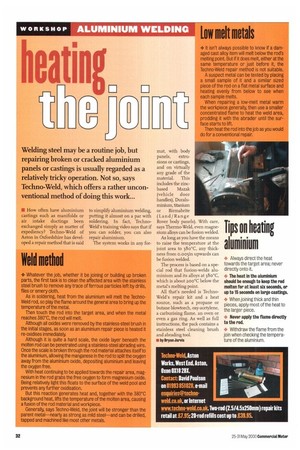Weld method
Page 34

If you've noticed an error in this article please click here to report it so we can fix it.
+ Whatever the job, whether it be joining or building up broken parts, the first task is to clean the affected area with the stainless steel brush to remove any trace of ferrous particles left by drills, files or emery cloth.
As in soldering, heat from the aluminium will melt the TechnoWeld rod, so play the flame around the general area to bring up the temperature of the metal.
Then touch the rod into the target area, and when the metal reaches 380'C, the rod will melt.
Although all oxides were removed by the stainless-steel brush in the initial stages, as soon as an aluminium repair piece is heated it re-oxidises immediately.
Although it is quite a hard scale, the oxide layer beneath the molten rod can be penetrated using a stainless-steel abrading wire. Once the scale is broken through the rod material attaches itself to the aluminium, allowing the manganese in the rod to split the oxygen away from the aluminium oxide, depositing aluminium and leaving the oxygen free.
With heat continuing to be applied towards the repair area, magnesium in the rod grabs the free oxygen to form magnesium oxide. Being relatively light this floats to the surface of the weld pool and prevents any further oxidisation.
But this reaction generates heat and, together with the 380°C background heat, lifts the temperature of the molten area, causing a fusion of the rod material and workpiece. Generally, says Techno-Weld, the joint will be stronger than the 11 parent metal—nearly as strong as mild steel—and can be drilled," tapped and machined like most other metals.
















































































































